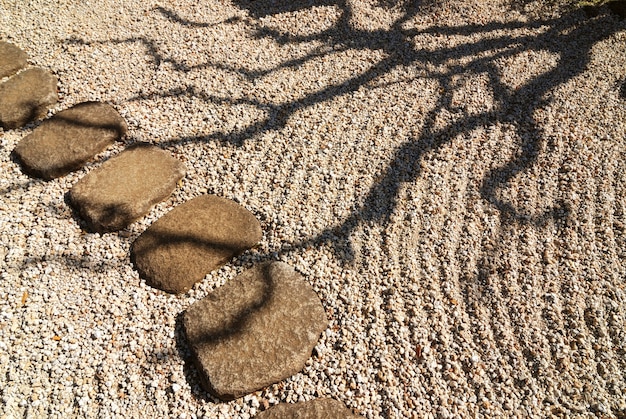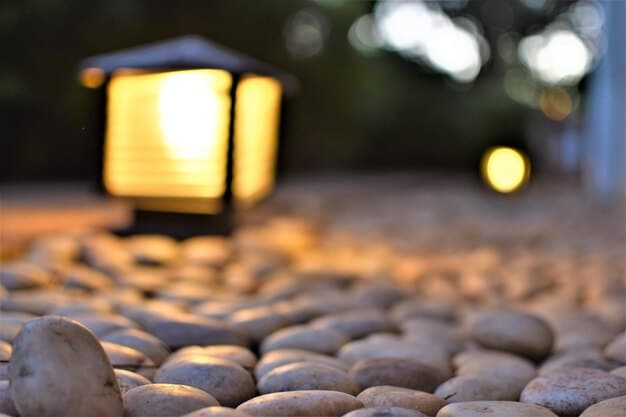Zen Gardening 2025: Mindful Spaces Under $500 Guide

Zen Gardening in 2025: A Practical Guide to Creating a Mindful Outdoor Space for Under $500 offers a budget-friendly approach to designing a serene retreat, focusing on minimalist design, affordable materials, and mindful practices to promote relaxation and well-being in your garden.
Are you looking to create a peaceful and serene outdoor space without breaking the bank? Zen Gardening in 2025: A Practical Guide to Creating a Mindful Outdoor Space for Under $500 provides you with simple and cost-effective methods to transform your backyard into a tranquil retreat.
What is Zen Gardening?
Zen gardening is more than just arranging plants and stones; it’s about creating a space for meditation and mindfulness. It’s a way to connect with nature and find peace in simplicity.
The Essence of Zen Design
Zen gardens, also known as Japanese rock gardens, emphasize simplicity, minimalism, and harmony. Key elements include rocks, gravel, sand, and carefully selected plants.
Why Zen Gardening in 2025?
In today’s fast-paced world, a Zen garden offers a sanctuary for relaxation and stress reduction. Creating one in 2025 means embracing sustainable and affordable practices.
- Reduces stress and promotes calmness.
- Enhances mindfulness and meditation practices.
- Creates a beautiful and peaceful outdoor space.
The principles of Zen gardening can easily be adapted to fit smaller spaces, making it ideal for urban dwellers.

By incorporating elements like carefully placed rocks and neatly raked gravel, you can mimic natural landscapes and create a sense of vastness.
Zen gardening is a commitment to balance and tranquility within your outdoor space. It encourages a slower pace of life, inviting moments of reflection amidst the natural beauty you’ve cultivated.
Planning Your Zen Garden on a Budget
Creating a Zen garden doesn’t require a huge investment. Careful planning and smart choices can keep your project under $500.
Assessing Your Space
Start by evaluating your available area. Consider the size, sunlight exposure, and existing features. This will help you determine the best layout and materials.
Sketching Your Design
Draw a simple plan of your garden. Include the placement of rocks, gravel, and plants. This visual guide will keep you on track and prevent costly mistakes.
- Measure your space accurately.
- Consider drainage and soil conditions.
- Plan for pathways and seating areas.
Prioritize essential elements to stay within budget. Focus on quality over quantity. A few well-chosen items can have a greater impact than many inexpensive ones.
Research local suppliers for cost-effective materials. Sometimes, reclaimed or repurposed items can add unique character to your garden.
Zen gardens are about achieving maximum effect with minimal elements. The more thought you put into your initial design, the easier and more affordable the execution will be.
Essential Elements for a Budget Zen Garden
Certain elements are fundamental to a Zen garden. Choosing affordable options for these will help maintain your budget.
Rocks and Stones
Rocks symbolize mountains and islands, representing stability and permanence. Opt for locally sourced rocks to save money.
Gravel and Sand
Gravel and sand represent water and create a sense of flow. Use inexpensive gravel or sand from local landscaping suppliers.
Plants
Select a few key plants that require minimal maintenance. Evergreen shrubs, moss, and ornamental grasses are good choices.
- Use native plants to reduce watering needs.
- Choose slow-growing plants to minimize pruning.
- Consider drought-tolerant varieties for low maintenance.
Consider using recycled materials to create unique features in your garden, adding character without additional cost.
By thoughtfully curating these elements, you’ll create a space that fosters tranquility and mindfulness without straining your budget.
DIY Zen Garden Features
Adding DIY features can enhance the beauty and functionality of your Zen garden while saving money.
Bamboo Fencing
Create a simple bamboo fence using bamboo poles from a local garden center. This adds privacy and creates a sense of enclosure.
Stone Lanterns
Make your own stone lanterns using concrete and molds. These add a touch of elegance and provide soft lighting at night.
Water Features
Construct a small water feature using a simple pump and a container. The sound of running water enhances the sense of tranquility.

Consider repurposing old containers or materials to create unique and cost-effective garden decorations.
DIY features not only save money but also allow you to personalize your Zen garden to reflect your unique style and creativity.
Maintaining Your Zen Garden in 2025
A Zen garden requires regular maintenance to preserve its beauty and tranquility. Fortunately, it’s easy to maintain a Zen garden on a budget.
Raking Gravel
Regularly rake the gravel to maintain clean lines and patterns. This is a meditative practice in itself.
Pruning Plants
Trim plants to maintain their shape and prevent them from overgrowing. This keeps the garden looking neat and orderly.
Weeding
Remove weeds regularly to prevent them from disrupting the harmony of the garden. A weed-free garden is a peaceful garden.
- Use organic gardening practices to avoid harmful chemicals.
- Water plants sparingly to conserve water.
- Add mulch to suppress weeds and retain moisture.
Regular maintenance is key to preserving the beauty and tranquility of your Zen garden. A little effort goes a long way.
By staying proactive with upkeep, you’ll ensure your Zen garden remains a peaceful retreat for years to come.
Enhancing Mindfulness in Your Zen Garden
The ultimate goal of a Zen garden is to promote mindfulness and relaxation. Here’s how to maximize those benefits.
Meditation Space
Create a designated area for meditation. This could be a simple bench or a flat rock.
Sensory Elements
Incorporate elements that engage the senses, such as wind chimes or fragrant plants.
Quiet Time
Set aside time each day to spend in your garden, practicing mindfulness and appreciating the beauty around you.
- Practice deep breathing exercises to calm your mind.
- Listen to nature sounds and observe the changing light.
- Reflect on your thoughts and feelings in a peaceful environment.
Your Zen garden should be a personal sanctuary, free from distractions and filled with tranquility.
By cultivating mindfulness within your Zen garden, you’ll create a space that nurtures both your mind and soul.
| Key Aspect | Brief Description |
|---|---|
| 🌱 Planning the Garden | Assess space, sketch design, prioritize essentials. |
| 💰 Budget-Friendly Materials | Local rocks, gravel, native plants, recycled items. |
| 🛠️ DIY Elements | Bamboo fences, stone lanterns, small water features. |
| 🧘 Mindfulness | Meditation space, sensory elements, quiet time. |
Frequently Asked Questions
The primary purpose is to create a tranquil space that promotes meditation, relaxation, and mindfulness through the simplicity and harmony of natural elements.
Yes, Zen gardens can be adapted to fit small spaces like balconies or patios. The key is to focus on minimalist design and carefully chosen elements.
Essential elements include rocks, gravel or sand, carefully selected plants, and often a water feature or stone lantern to enhance the sense of tranquility.
The cost varies, but you can create a beautiful Zen garden for under $500 by using locally sourced materials, DIY features, and carefully planning your design.
Maintenance involves regularly raking gravel, pruning plants, removing weeds, and ensuring that the garden remains a peaceful and orderly space for meditation.
Conclusion
Creating a Zen Gardening in 2025: A Practical Guide to Creating a Mindful Outdoor Space for Under $500 is an achievable goal that brings peace and tranquility to your life. By planning carefully, using affordable materials, and embracing DIY features, you can transform your outdoor space into a mindful retreat without exceeding your budget.





